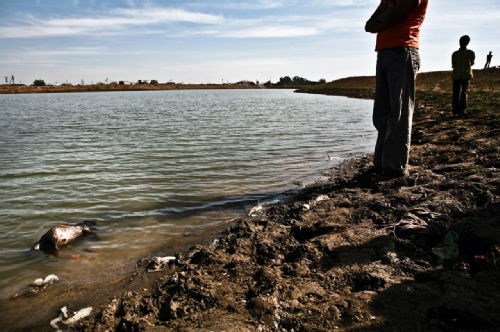All entries for Monday 09 January 2023
January 09, 2023
Disaster and the Territorial Body
Writing about web page https://warwick.ac.uk/fac/arts/hrc/confs/territorialbodies/
In this blog, HRC Doctoral Fellow Charlotte Spear, reflects on how the conference - 'Territorial Bodies: World Culture in Crisis' links to one of the most recent chapters of her own thesis.
In the aftermath of the devastating 1984 Bhopal Gas Tragedy, Raghu Rai takes one of the most famous images to come out of the disaster, “An Aborted Foetus When The Tragedy Struck, 1984” (Rai). Unborn babies are contorted and forced into the space of makeshift test tubes, cruelly taken from the safety of their mothers’ wombs after the release of ‘46.3 tons of methyl isocyanate from the factory run by the Union Carbide corporation, an American transnational with a pesticide-manufacturing facility in Bhopal, India’ (Kovel 28), killing between 5,000-10,000 people instantly and leaving over 500,000 injured (Kovel 28). These children, simultaneously prematurely born and yet fated never to be born, by what we now know to have been an avoidable disaster, are pictured on a wall overlooking a city. They are both within and without, overlooking and overlooked by the cityscape behind.
Rai, like streams of other photographers, writers and activists following the disaster, intimately connects non-human place and the human body in his work. Bhopal becomes the horrific archetype of Naomi Klein’s sacrifice zone; those zones which are abandoned to the toxicity of a contemporary energy regime which is ‘so inherently dirty and toxic that [it requires] sacrificial people and places: people whose lungs and bodies can be sacrificed’(Klein). Whilst we often think of disasters as somehow accidental, sudden, ‘a rupture or inversion of the normal order of things’ (Anderson 1), the Bhopal Tragedy was none of these. Union Carbide ‘had designed the plant in a way that made accidents more or less inevitable’, ‘switched to the use of [methyl isocyanate] in order to produce more cheaply’ and built the plant in an area close to the population of Bhopal in order to save money (Kovel 32).
Not only does the disaster harm the people who breathe in this toxicity, a toxicity which ‘is driven inward, somatized into cellular dramas of mutation that – particularly in the bodies of the poor – remain largely unobserved, undiagnosed, and untreated’ (Nixon 6), but it lingers in the other-than-human nature which absorbs the poisons and houses them even now. Multiple reports over the last few decades have found the soil and water in the area to hold significantly higher than safe levels of a variety of chemicals including mercury, organochlorine compounds (Labunska et al. 3), lead, pesticides, Volatile Organic Compounds and Halo-Organics (Surviving Bhopal 2002: Toxic Present - Toxic Future).

Andy Spyra/Getty Images
“January 24 2007: Local men are standing on the edge of a contaminated water pond which was used for cooling the factory but got completely poisoned after the gas-leak. In the water swims the remains of a dead dog.”
The status of the people and land of Bhopal as somehow sacrificial extends into and directly impacts upon the fight for justice after the disaster. After the case was originally brought to court in the US, Judge Keenan mandated the Bhopal case to the Indian courts on May 12th 1968 under the auspices that ‘the Indian legal system is in a far better position than the American courts to determine the cause of the tragic event and thereby fix liability’(Baxi 68). As Mukherjee argues, ‘this legal defence is in effect a philosophical position that assumes an unbridgeable gap between two apparently discontinuous worlds. What is human in one, is not so in the other’ (Mukherjee 142).
And so, the question becomes, where are universal human rights in all of this? A large American company cuts corners to save costs, and in doing so essentially sacrifices not only the land on which the Union Carbide factory stood, but also the population surrounding it, many of whom lost their lives. As the people of Bhopal attempt to seek justice for this dire abuse of their human rights, their fight for justice is forcibly spatialised; not allowed to exist in the ‘world’ or ‘universal’ human rights, but rather enforced as a distinctly Bhopali issue. In this sense, then, the experience of so-called ‘universal human rights’ appears in fact to be entirely dependent on locationality: the human body as the site of the abuse of human rights becomes not a singular unit but rather entirely relational with the land and geopolitical organisation of that land. The body, in its experience of – and abuse of – human rights, becomes inherently the geopolitically territorial body.
Keywords:
Disaster, territorial, body, rights, Bhopal
Works Cited
Anderson, Mark D. Disaster Writing: The Cultural Politics of Catastrophe in Latin America. University of Virginia Press, 2011.
Baxi, Upendra, editor. ‘Judge Keenan’s Decision’. Inconvenient Forum and Convenient Catastrophe, N.M. Tripathi PVT. LTD., 1986, pp. 35–69.
Klein, Naomi. ‘Let Them Drown: The Violence of Othering in a Warming World’. London Review of Books, vol. 38, no. 11, June 2016, https://www.lrb.co.uk/the-paper/v38/n11/naomi-klein/let-them-drown.
Kovel, Joel. ‘Capital’. The Enemy of Nature: The End of Capitalism or the End of the World?, by Joel Kovel, Zed Books, 2007, pp. 26–50.
Labunska, I., et al. The Bhopal Legacy: Toxic Contaminants at the Former Union Carbide Factory Site, Bhopal, India: 15 Years after the Bhopal Accident. microform, Greenpeace Research Laboratories, Dept. of Biological Sciences, University of Exeter, 1999.
Mukherjee, Upamanyu Pablo. ‘Dead Air: Indra Sinha’. Postcolonial Environments: Nature, Culture and the Contemporary Indian Novel in English, by Upamanyu Pablo Mukherjee, Palgrave Macmillan/Arts & Humanities Research Council, 2010, pp. 134–62.
Nixon, Rob. ‘Introduction’. Slow Violence and the Environmentalism of the Poor, Harvard University Press, 2011, pp. 1–44.
Rai, Raghu. An Aborted Foetus When The Tragedy Struck, 1984. Online, 1984, https://raghuraifoundation.org/bhopal/.
Surviving Bhopal 2002: Toxic Present - Toxic Future. Shrishti, 2002.
 Sue Rae
Sue Rae

 Please wait - comments are loading
Please wait - comments are loading
 Loading…
Loading…